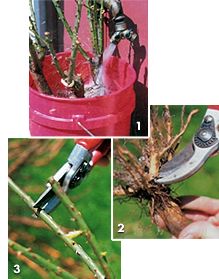





 Growing beautiful roses
starts with proper planting.
Growing beautiful roses
starts with proper planting.
You'd never guess that such lovely flowers could spring from anything as homely as a bare-root rose. This awkward assemblage of stubby, thorny canes and wiry roots is poised for quick growth, making bare-roots the first choice of experienced gardeners. Look for dormant plants, their roots swaddled in plastic, in garden centers or nursery catalogs. Bare-root roses settle in with a minimum of transplant shock, then swiftly move on to the business of cranking out flowers.
continue reading below Soak, clip, and trim your
stems before planting.
Soak, clip, and trim your
stems before planting.
1. On planting day, refresh the roots in a bucket of water while you dig the planting hole. An hour-long soaking plumps up shriveled roots.
2. Clip off damaged roots (this one is cracked). Shorten roots that are too long to fit in the planting hole without bending.
3. Some rose sellers trim the stems, or canes, for you. More likely, you'll need to prune them yourself. Remove the broken ends of canes, canes with blackened or diseased spots, and twiggy growth. Leave three to five sturdy canes in an open-centered arrangement. Cut back any extra-long canes so all are about the same length. Don't worry about making a pruning mistake; it's hard to go wrong.
4. Timing is crucial for bare-root planting: in most areas bare-root roses should be planted in early spring before their leaves unfurl; where temperatures rarely dip below 20 degrees, winter planting is best. If you can't plant a bare-root rose right away, keep its roots moist and cool. An alternative to bare-root roses -- container-grown or "potted" roses -- can be planted any time they're available. Potted roses are a convenient way to extend the planting season.
Download our helpful chart on roses for every purpose. (Downloading requires Adobe Acrobat software.)
Roses for every purpose
Download Adobe Acrobat
Copyright © www.100flowers.win Botanic Garden All Rights Reserved